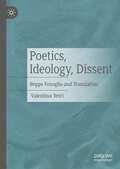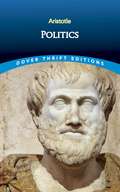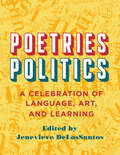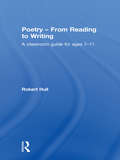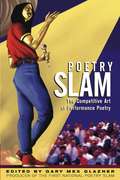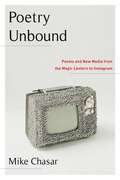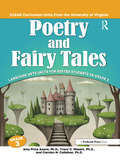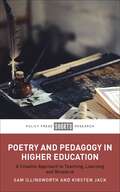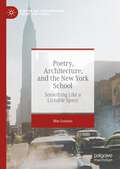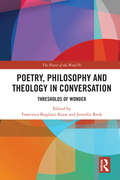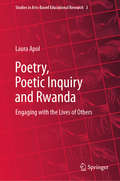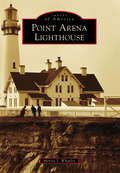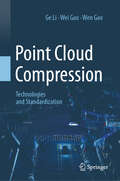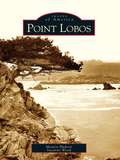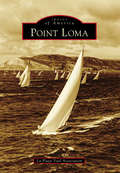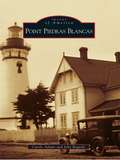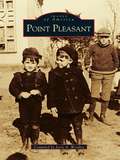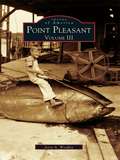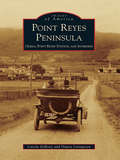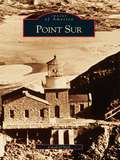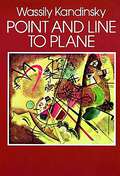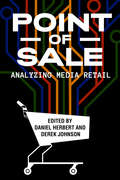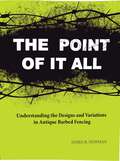- Table View
- List View
Poetics, Ideology, Dissent: Beppe Fenoglio and Translation
by Valentina VetriThis book examines the translations carried out by Italian novelist Beppe Fenoglio, one of the most important Italian writers of the twentieth century. It stems from the acknowledgement that Beppe Fenoglio’s translations have not been examined in the political, cultural and ideological context in which they were produced, but have been dismissed as a purely linguistic exercise. The author examines Fenoglio’s translations as culturally and ideologically informed artistic expressions, in which Fenoglio was able to give voice to his dissent towards the mainstream ideology and poetics of his times, often choosing authors and characters with whom he identified, such as Shakespeare, Milton and Marlowe. The interaction between the theories of Translation Studies, Literary Theory and Adaptation Studies foregrounds the centrality of the role of the translator, showing how Fenoglio’s ideology and poetics were clearly visible both in the selection of the texts he translated and in his translation strategies.
Poetics: A Treatise On Government (Dover Thrift Editions)
by AristotleAmong the most influential books in Western civilization, the Poetics is really a treatise on fine art. It offers seminal ideas on the nature of drama, tragedy, poetry, music, and more, including such concepts as catharsis, the tragic flaw, unities of time and place and other rules of drama. This inexpensive edition enables readers to enjoy the critical insights of one humanity's greatest minds laying the foundations for thought about the arts.
Poetries - Politics: A Celebration of Language, Art, and Learning
by Mary Shaw Francois Cornilliat Atif Atkin Ouafaa Deleger Ian Lovoulos Devon Monaghan Jenevieve DeLosSantosPoetries – Politics: A Celebration of Language, Art, and Learning celebrates the best of innovative humanities pedagogy and creative graphic design. Designed and implemented during a time of political divisiveness, the Poetries – Politics project created a space of inviting, multilingual walls on the Rutgers campus, celebrating diversity, community, and cross-cultural exchange. This book, like the original project, provides a platform for the incredible generative power of student-led work. Essays feature the perspectives of three students and professors originally involved in the project, reflecting on their learning and exploring the works they selected for the original exhibition. The essays lead to a beautifully illustrated catalogue of the original student designs. Reproduced in full color and with the accompanying poems in both their original language and a translation, this catalogue commemorates the incredible creative spirit of the project and provides a new way of contemplating these great poetic works.
Poetry - From Reading to Writing: A Classroom Guide for Ages 7-11
by Robert HullPoetry – From Reading to Writing covers the process of writing poetry, from reading poems through to writing them. It is intended particularly for teachers at key stage 2 level, but other teachers will also find it valuable. It is clearly and accessibly written and jargon-free. In providing a wealth of practical ideas and activities preparing for the writing of poems, the book also stresses the use of talk, improvised drama and the reading and performance of poems. The author, who has published four collections of poetry, uses his own work and the work of others to explore how creative readings of poems can spark a child’s imagination and lead to original writing. Pupils are encouraged throughout the book to explore different forms of poetry, including: Rhyming and non-rhyming poems Riddles Short poems Haiku, tanka, renga Poems from stories Free verse Narrative poems Poems drawing on current affairs and history This book can be used by both pupils and teachers, and contains motivating tasks and tips to build pupils’ confidence in poetry writing. Explicit links are made throughout to the latest primary framework for literacy, making this an invaluable resource for all practising and trainee teachers who wish to teach poetry in the classroom in a creative and enjoyable way.
Poetry Slam
by Gary GlaznerPoetry Slam: The Competitive Art of Performance Poetry documents the first ten years of this cultural phenomenon with details on slam history and rules, hosting your own slam, winning strategies, tips for memorization, crafting group pieces, and other informative essays, as well as 100 of the best slam-winning poems ever.
Poetry Unbound: Poems and New Media from the Magic Lantern to Instagram
by Mike ChasarIt’s become commonplace in contemporary culture for critics to proclaim the death of poetry. Poetry, they say, is no longer relevant to the modern world, mortally wounded by the emergence of new media technologies. In Poetry Unbound, Mike Chasar rebuts claims that poetry has become a marginal art form, exploring how it has played a vibrant and culturally significant role by adapting to and shaping new media technologies in complex, unexpected, and powerful ways.Beginning with the magic lantern and continuing through the dominance of the internet, Chasar follows poetry’s travels off the page into new media formats, including silent film, sound film, and television. Mass and nonprint media have not stolen poetry’s audience, he contends, but have instead given people even more ways to experience poetry. Examining the use of canonical as well as religious and popular verse forms in a variety of genres, Chasar also traces how poetry has helped negotiate and legitimize the cultural status of emergent media. Ranging from Citizen Kane to Leave It to Beaver to best-selling Instapoet Rupi Kaur, this book reveals poetry’s ability to find new audiences and meanings in media forms with which it has often been thought to be incompatible. Illuminating poetry’s surprising multimedia history, Poetry Unbound offers a new paradigm for understanding poetry’s still evolving place in American culture.
Poetry and Fairy Tales: Language Arts Units for Gifted Students in Grade 3
by Carolyn M. Callahan Amy Price Azano Tracy C. MissettThe CLEAR curriculum, developed by University of Virginia's National Research Center on the Gifted and Talented, is an evidence-based teaching model that emphasizes Challenge Leading to Engagement, Achievement, and Results. In Poetry and Fairy Tales: Language Arts Units for Gifted Students in Grade 3 students will read and analyze various forms of poetry and write their own poetry anthology. They will learn how to identify and use figurative language to create concrete images from abstract ideas. In the fairy tales unit, students will study fairy tales and folklore to understand how and why societal norms and mores are culturally transmitted. These units focus on critical literacy that includes reading diverse sources, understanding bias and cultural contexts, and creating informed consumers of information.Grade 3
Poetry and Pedagogy in Higher Education: A Creative Approach to Teaching, Learning and Research
by Sam Illingworth Kirsten JackThis book invites us to consider the profound impact that poetry can have in shaping personal and professional development in a higher education setting. Suitable for educators, learners, and practitioners, it offers a transformative learning approach in using poetry for teaching, assessment, research, and reflection. The book includes diverse examples, case studies, and practical exercises, demonstrating poetry's application in personal and professional development in a higher education setting. Each chapter guides readers through these processes, empowering them to integrate poetry into their own teaching and learning practices in a way that is creative, inclusive, and impactful.
Poetry, Architecture, and the New York School: Something Like a Liveable Space (Modern and Contemporary Poetry and Poetics)
by Mae LosassoPoetry, Architecture, and the New York School: Something Like a Liveable Space examines the relationship between poetics and architecture in the work of the first generation New York School poets, Frank O’Hara, John Ashbery, Barbara Guest, and James Schuyler. Reappraising the much-debated New York School label, Mae Losasso shows how these writers constructed poetic spaces, structures, surfaces, and apertures, and sought to figure themselves and their readers in relation to these architextual sites. In doing so, Losasso reveals how the built environment shapes the poetic imagination and how, in turn, poetry alters the way we read and inhabit architectural space. Animated by archival research and architectural photographs, Poetry, Architecture, and the New York School marks a decisive interdisciplinary turn in New York School studies, and offers new frameworks for thinking about postmodern American poetry in the twenty-first century.
Poetry, Philosophy and Theology in Conversation: Thresholds of Wonder: The Power of the Word IV
by Jennifer Reek Francesca Bugliani KnoxThis volume is a collection of essays that explains how literature, philosophy and theology have explored the role of wonder in our lives, particularly through poetry. Wonder has been an object of fascination for these disciplines from the Greek antiquity onwards, yet the connections between their views on the subject are often ignored in subject specific studies. The book is divided into three parts: Part I opens the conversation on wonder in philosophy, Part II is given to theology and Part III to literary perspectives. An international set of contributors, including poets as well as scholars, have produced a study that looks beyond traditional chronological, geographical and disciplinary boundaries, both within the individual essays themselves and in respect to one another. The volume’s wide historical framework is punctuated by four poems by contemporary poets on the theme of wonder. An unconventional foray into one of the best-known themes of the European tradition, this book will be of great interest to scholars of literature, theology and philosophy.
Poetry, Physics, and Painting in Twentieth-Century Spain
by Candelas GalaThis book reads the work of Salinas, Guill#65533;n, Larrea, Diego, Alberti, M#65533;ndez, and Lorca in analogical relation with Cubism and with the revolutionary discoveries of modern physics. Gala advances traditional criticism by considering these artists in the broader cultural context of Spain, Europe, and European Modernism.
Poetry, Poetic Inquiry and Rwanda: Engaging with the Lives of Others (Studies in Arts-Based Educational Research #3)
by Laura ApolThis book describes the practice of poetic inquiry and takes the reader through the process of translating lived experience into poetry that attends to the lives of others. Using her own writing—from early drafts to published poems—Apol demonstrates elements of poetic inquiry that both give it strength and make it complicated: the importance of craft (the aesthetic); the imperative of accuracy and reliability (the investigative); the significance of ethical responsibility that leads to action (witness); and the centrality of relational connectedness and accountability (withness). Apol raises questions about what it means for poems to function as both research and art, and illustrates what happens when there are irresolvable conflicts between the demands of the poem and a commitment to relationship. Throughout, Apol addresses her white privilege, as well as the dominant white/colonial narrative that often seeps into arts-based work unless it is overtly and critically addressed. The book goes beyond arts-based research, speaking as well to other forms of cross-national, cross-cultural research. It is a call for relational scholarship that moves toward action, a heart-rending teaching, a post-traumatic aesthetic map laid down with clear and poignant theory and praxis to extend, serve and guide.
Point Arena Lighthouse
by Merita S. WhatleyThe low rumbles of the fog signal and flashing beam of light from the powerful lens have guided mariners away from the perilous waters surrounding Point Arena Lighthouse since 1870. After the great earthquake in 1906 and the rebuilding of the tower in 1908, Point Arena's navigational aids continued to warn ships away from the peninsula off Northern California's Pacific coastline. The original tower was replaced with a concrete cylindrical tower that rises 115 feet from the headland. This became the first lighthouse tower in the United States constructed with materials found to be superior to the stone and masonry lighthouse structures of the past. The new tower, crowned with a nearly 13,000-pound first-order Fresnel lens, sent a beam of light 20 miles out to sea and continued alerting ships of the dangers just offshore.
Point Cloud Compression: Technologies and Standardization
by Wen Gao Wei Gao Ge Li3D point clouds have broad applications across various industries and have contributed to advancements in fields such as autonomous driving, immersive media, metaverse, and cultural heritage protection. With the fast growth of 3D point cloud data and its applications, the need for efficient compression technologies has become paramount. This book delves into the forefront of point cloud compression, exploring key technologies, standardization efforts, and future prospects. This comprehensive book uncovers the foundational concepts, data acquisition methods, and datasets associated with point cloud compression. By examining the fundamental compression technologies, readers can obtain a clear understanding of prediction coding, transform coding, quantization techniques, and entropy coding. Through vivid illustrations and examples, the book elucidates how these techniques have evolved over the years and their potentials for the future. To provide a complete picture, the book presents cutting-edge research methods in point cloud compression and facilitates comparisons among them. Readers can be equipped with an in-depth understanding of the latest advancements, and can gain insights into the various approaches employed in this dynamic field. Another distinguishing aspect of this book is its exploration of standardization works for point cloud compression. Notable standards, such as MPEG G-PCC, AVS PCC, and MPEG V-PCC, are thoroughly illustrated. By delving into the methods used in geometry-based, video-based, and deep learning-based compression, readers become familiar with the latest breakthroughs in the standard communities.
Point Lobos
by Monica Hudson Suzanne WoodFor more than a century the incomparable beauty of Point Lobos has drawn admirers from around the world. The jagged rock outcroppings, driftwood-strewn beaches, and silhouetted cypress trees, twisted grotesquely by the wind, were favorite subjects for photographers Ansel Adams and Edward Weston. Point Lobos is also a favorite playground for seals, sea lions, and otters, and migrating grey whales pass just offshore. Barking sea lions reminded 18th-century Spanish explorers of sea wolves, in their tongue, lobos marinos, and so they named it Point of the Sea Wolves. Now a California State Reserve, Point Lobos draws hundreds of thousands of visitors a year.
Point Loma (Images of America)
by La Playa Trail AssociationFrom the arrival of Juan Rodriguez Cabrillo in 1542 to the current world-class yachtsmen and women, San Diego's beautiful natural harbor hugs the peninsula of Point Loma and boasts a significant past. The strategic location of Point Loma has been home to both military defense and business genius. The fishing fleets of the Chinese and Portuguese communities earned the Roseville area of Point Loma the nickname "Tunaville." Today, Point Loma is one of San Diego's most historic neighborhoods; a destination for culture, fine dining, and sportfishing; and host to important military bases. Visitors from around the world enjoy spectacular vistas and waterfront views of the Pacific Ocean, harbor, city, and islands and mountains of Mexico from atop the peninsula at Cabrillo National Monument and Fort Rosecrans National Cemetery.
Point Piedras Blancas (Images of America)
by Carole Adams John H. BogackiFor thousands of years, Point Piedras Blancas, located along the central coast of California, has attracted people to its rocky, windswept shores. In ancient times, it was used by Native American cultures. Since 1875, it has been the site of a First Order Lighthouse, warning ships to steer clear of its rocky shoals, a duty it continues to fulfill. Although the years have not been kind to this stunning area nor to the lighthouse, new life is being breathed into it by a partnership of enthusiastic community volunteers and government agencies. Their common goal is to restore this magnificent site to its original state while reintroducing the natural environment that was almost obliterated during the past four decades.
Point Pleasant (Images of America)
by Jerry A. WoolleySince the development of photography in the midnineteenth century, the camera has been used as a tool of both discovery and preservation. Photographs bring alive our image of the past, and can open a floodgate of memories and nostalgia or inspire curiosity and a sense of history. Point Pleasant and Point Pleasant Beach have always been two of New Jersey's most dynamic coastal communities. The scenic beauty and simple charm of the area remains undisturbed today, and it is easy to see why it has been a popular tourist destination for more than two centuries. The last one hundred years have also seen the formation and development of several important industries in the region, including shipbuilding and commercial fishing. This combination of business and recreation, of modern industry and Old World charm, is why Point Pleasant and Point Pleasant Beach remain two of the most vivacious and magnetic communities on the coast of New Jersey.
Point Pleasant: Volume III (Images of America)
by Jerry A. WooleyPoint Pleasant Volume I and Volume II have captivated audiences, and now, in this new addition to the Images of America series, author Jerry Woolley offers us a third volume of images to help us connect with our past. In Point Pleasant Volume III, we are invited to take a stroll down memory lane and see the area's residents at work and at play, boating and fishing, and simply relaxing on the beach. Also featured within these pages are a variety of snapshots of the places and events that have given this community its Old World familiarity. Its no wonder that Point Pleasant and Point Pleasant Beach have been popular tourist destinations for more than two centuries.
Point Reyes Peninsula: Olema, Point Reyes Station, and Inverness
by Dewey Livingston Carola DerooyThe Point Reyes Peninsula has a rich history encompassing thriving Native American settlements, visits by Francis Drake and Spanish explorers, dramatic shipwrecks, Mexican rancheros, famous dairy farms, railroads, and one of the country's most spectacular lighthouses. These historical facets spawned the three small towns of Olema, Point Reyes Station, and Inverness; each is unique with its own distinctive foundations. Most of the land is now within Point Reyes National Seashore, a refuge created during the Kennedy administration and now one of the more popular destinations on the California coast. The unique geography of the forest, bay, and ocean environments and the abundant wildlife in Point Reyes offers fine scenery, diverse recreational opportunities, and good food and lodging, while the towns retain their old-time character.
Point Sur (Images of America)
by Carol O’neilPoint Sur Lightstation was carved out of solid volcanic rock more than a century ago. When the light was turned on in 1889, no towns or roads were nearby to support the four families that lived atop the giant "moro" rock located just offshore in Big Sur, California. These vintage images tell the story of Pt. Sur Lightstation with its state-of-the-art lighthouse and fog signal system, and the lightkeepers and their families who kept it operating until 1974. The remote location and treacherous coast were constant adversaries. Today, Pt. Sur's lighthouse is automated. The vacant lightstation buildings are a ghost town that reminds us of our proud maritime heritage and the hearty souls who helped light the way.
Point and Line to Plane
by Wassily Kandinsky"I had the impression that here painting itself comes to the foreground; I wondered if it would not be possible to go further in this direction."Thus did the young Russian painter Wassily Kandinsky (1866–1944) react to his first viewing of Monet's Haystack, included in an 1895 Moscow exhibit of French Impressionists. It was his first perception of the dematerialization of an object and presaged the later development of his influential theories of non-objective art.During study and travel in Europe, the young artist breathed the heady atmosphere of artistic experimentation. Fauvism, Cubism, Symbolism, and other movements played an important role in the development of his own revolutionary approach to painting. Decrying literal representation, Kandinsky emphasized instead the importance of form, color, rhythm, and the artist's inner need in expressing reality.In Point and Line to Plane, one of the most influential books in 20th-century art, Kandinsky presents a detailed exposition of the inner dynamics of non-objective painting. Relying on his own unique terminology, he develops the idea of point as the "proto-element" of painting, the role of point in nature, music, and other art, and the combination of point and line that results in a unique visual language. He then turns to an absorbing discussion of line — the influence of force on line, lyric and dramatic qualities, and the translation of various phenomena into forms of linear expression. With profound artistic insight, Kandinsky points out the organic relationship of the elements of painting, touching on the role of texture, the element of time, and the relationship of all these elements to the basic material plane called upon to receive the content of a work of art.Originally published in 1926, this essay represents the mature flowering of ideas first expressed in Kandinsky's earlier seminal book, Concerning the Spiritual in Art. As an influential member of the Bauhaus school and a leading theoretician of abstract expressionism, Kandinsky helped formulate the modern artistic temperament. This book amply demonstrates the importance of his contribution and its profound effect on 20th-century art.
Point of Sale: Analyzing Media Retail
by Daniel Herbert Derek Johnson Avi Santo Benjamin Woo Emily West Marc Steinberg Lynn Comella Courtney Brannon Donoghue Ethan Tussey Tim J. Anderson Evan Elkins Erin Hanna Greg Steirer Heikki Tyni Olli Sotamaa Elizabeth Affuso Meredith A. Bak Nasreen RajaniPoint of Sale offers the first significant attempt to center media retail as a vital component in the study of popular culture. It brings together fifteen essays by top media scholars with their fingers on the pulse of both the changes that foreground retail in a digital age and the history that has made retail a fundamental part of the culture industries. The book reveals why retail matters as a site of transactional significance to industries as well as a crucial locus of meaning and interactional participation for consumers. In addition to examining how industries connect books, DVDs, video games, lifestyle products, toys, and more to consumers, it also interrogates the changes in media circulation driven by the collision of digital platforms with existing retail institutions. By grappling with the contexts in which we buy media, Point of Sale uncovers the underlying tensions that define the contemporary culture industries.
Point of it All: Understanding the Designs and Variations in Antique Barbed Wire
by James R. NewmanThe Point of it All is a thoroughly documented, researched book about the history of the designs of antique barbed fencing. This book describes hundreds of patents and over 2,000 patent design variations found in antique barbed fencing. Varieties such as mild steel barbed wire strands, sheet metal barbed strips, barbed metal rods, and barbed wooden rails. Antique barbed fencing evolved from the wooden fences and plain wire fences of the 1850s. The major antique barbed fencing period occurred from the late 1860s and mid-1870s to early 1900s when inventors in the Midwest and Northeast designed hundreds of new ways to corral livestock. Using US Patent and Trademark Office records and other information sources, the author describes how the inventors considered their patent designs unique, what their purpose was, and what factors influenced the changes in these designs over time. The author describes the common patterns found in the structure and form of these patent designs. Because of the complexity in these designs the author provides a proposed classification system for antique barbed fencing which can be used for sorting, organizing and indexing barbed fencing patents into similar patents and design groups. This book is intended for collectors, farm historians, and those of us who have ripped our pants crossing barbed wire fences.
Point, Click, Quilt!: Turn Your Photos into Fabulous Fabric Art
by Susan Brubaker Knapp“[A] gem . . . [Susan] provides a wealth of tips and examples for composing great photographs that have potential to make for lovely quilts.” —Piece, Love & Happiness!Fiber artist and designer Susan Brubaker Knapp teaches quilters how to compose and shoot dynamic digital photos from a quilter’s perspective. With fun, creative workshop-like exercises in art quilting, you’ll learn how to turn those photos into small art quilts, both realistic and abstract, combining traditional fabrics with innovative materials. Every quilter can succeed with Susan’s achievable designs and accessible techniques.16 artful appliqué projects inspired by digital photographsLearn how to shoot better photos and turn them into art quilt designsBoost your creativity with new tools and techniquesUse unique materials to achieve your vision, including Tyvek, foils, paints, and more“Shows how a photo can be a starting point for something truly artful . . . The focus is on creating good design, not on simply recreating a scene . . . anyone who ever made a piece inspired by a favorite photo can learn something from this beautiful book.” —And Sew It Goes . . .“I sat down and went through each page and gobbled it right up . . . Susan shares how to take great photos for translation into an art quilt.” —IHAN (I Have a Notion)
